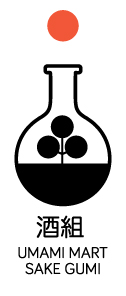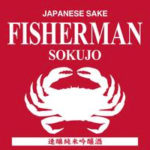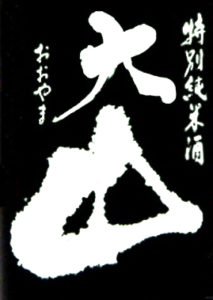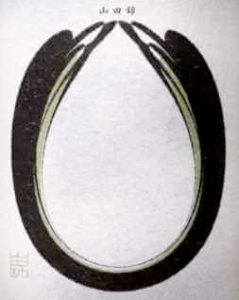Sake Gumi News: Happy 1st Birthday Sake Gumi (August 2016)
 August sakes ship today for Sake Gumi, our monthly sake subscription club. If you like what's on deck here, you should join!
August sakes ship today for Sake Gumi, our monthly sake subscription club. If you like what's on deck here, you should join!"Celebrating Design, Drinks, + Japan" is at the core of everything we do at Umami Mart. It is our tag line, afterall. Four years ago today, full of giddiness and hope, Kayoko and I took a huge chance when we flipped the sign to “open” at our store in Oakland. In the same spirit, one year ago, we launched Sake Gumi simply because we thought it would “be fun to start a club.” Since then, the New York Times has written about our “little” club (140 members and counting) and just last month, the East Bay Express named Sake Gumi the “Best Booze Club.” So to celebrate the birthdays of Umami Mart and Sake Gumi, I chose sakes that encompass our ethos.
Design has always been a pillar at Umami Mart. Our hope is that when you walk into Umami Mart or visit us online, you enter a space that is clean, playful, and fresh. So when choosing this month’s sakes, I took into account the labels that adorn each bottle. From the clean and modern ENTER.Sake Honjozo label to the fresh, yet timeless Ohyama Tokubetsu Junmai label, I hope that at least one of these designs inspires you. This is important to me, as I consider all of us in the club to be the most discerning of design geeks.
It’s probably prettay, prettaaay, prettaaaaaaaay* obvious to you by now that drinks are a big thing at Umami Mart. Back in 2010, we started importing barware as our main product line, but having sakes and beers on our shelves since 2015 has really brought things to life. And to continue on the drinks trajectory, Sake Gumi is a natural part of the narrative. And don’t worry, we’ve got a lot more up our sleeves. We are just getting started.
And finally Japan. As someone who has spent 2/3 of her life in the US and 1/3 in Japan, I am committed to demystifying both cultures to each other and exposing the truth that all anyone wants as a human being is to find love, have a good job, and live in a space that has temperature control. With this in mind, raise a glassful of this month’s sakes to love, hard work, and air conditioning.
I want to thank you for taking a chance on the Gumi, and being a part of the Umami Mart family. It’s been a wild ride! As Conner4Real would say: Never Stop Never Stopping!
Yoko
* If you are unfamiliar with this phrase, stop reading this and watch Curb Your Enthusiasm right now.
LEVEL 1: Introductory Membership (Two 300ml bottles)
 Fisherman Sokujo Junmai Ginjo
Fisherman Sokujo Junmai GinjoShiokawa Sake Brewery (Niigata, Japan)
Seimaibuai: 60%
SMV: -13.7
This juicy junmai ginjo that is reminiscent of a young Riesling is best enjoyed chilled with shellfish. The high acid and fruitiness of this sake pairs well with shrimp sauteed in garlic and butter. For inquiring minds, sokujo is the term used to describe the modern process of making sake (which means lactic acid is added into the yeast starter vs. the more traditional methods of yamahai and kimoto, where lactic acid forms naturally). The sokujo method tends to yield cleaner, less funky brews.
 Ohyama Tokubetsu Junmai
Ohyama Tokubetsu JunmaiOhyama Brewery (Yamagata, Japan)
Seimaibuai: 60%
SMV: +4.5
Sake drinkers who like a clean, dry brew will enjoy this tokubetsu junmai from Yamagata Prefecture. With an assertive, alcoholic backbone, this sake pairs well with food that has some sweetness to it: zaru soba with tsuyu, BBQ chicken, and uni kurage were just some dishes I enjoyed alongside this sake. As things finally heat up in Oakland, I’ve been drinking this sake chilled, but have also enjoyed it slightly warm on cold nights.
LEVEL 2: Premium Membership (Two 720ml bottles)
 ENTER.Sake Black Dot Honjozo
ENTER.Sake Black Dot HonjozoSekiya Brewery (Aichi, Japan)
Seimaibuai: 65%
SMV: N/A
This refreshingly dry, clean, and clear sake is a winner when it comes to pleasing the masses. It tastes the best chilled and pairs with everything from a lightly dressed salad to a burger. But the real story here is that the brewer refuses to disclose the sake meter value (or SMV, which measures the density of sake relative to water, and is the barometer for gauging the dryness or sweetness of the sake), which rarely happens in the sake community. The reason he does not want to reveal the SMV is so not to sway people’s perceptions or taste before they actually drink the sake.
 Shinpaku Junmai Daiginjo
Shinpaku Junmai DaiginjoNanbu Bijin Brewery (Iwate, Japan)
Seimaibuai: 50%
SMV: +4
Shinpaku refers to the starchy core of rice grains. When rice is polished for making daiginjo sake, at least 40% of the outer portion of the rice needs to be removed, leaving the shinpaku. When rice grains are polished down, revealing the shinpaku, brewers can create more aromatic, fruity brews. This sake is no exception. It has a smooth aroma of pears (and a hint of mushrooms upon opening) and a structured sweetness in taste that is mild yet ends dry. Enjoy this bottle chilled at your next oyster or temaki sushi party!
